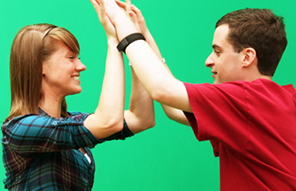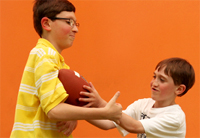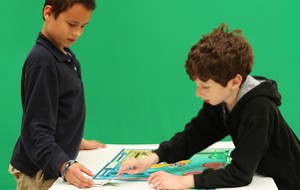
Special Education  Socialization and Independence. We began our presentation by asking those in attendance to write a list of ten things they did before arriving at the conference. We then asked them to label if the task involved a social, independent, or academic skill. Not surprisingly, the vast majority of everyones list included social and independent skills while very little, if any at all, involved academics. It is so important for children to learn appropriate social skills and daily living skills to be valuable members of a community.
Socialization and Independence. We began our presentation by asking those in attendance to write a list of ten things they did before arriving at the conference. We then asked them to label if the task involved a social, independent, or academic skill. Not surprisingly, the vast majority of everyones list included social and independent skills while very little, if any at all, involved academics. It is so important for children to learn appropriate social skills and daily living skills to be valuable members of a community.
 For this program to be successful, it is imperative to have the support of all staff members involved. This includes your building administrator, general education teachers, and paraprofessionals.
Create a team to lead the program and then have a meeting to discuss what your program will look like. We met with other districts who had a peer-to-peer support model already started to help us out. A lot of our ideas and inspiration came from START (statewide autism training and resources) and Clarkston Highschool.
We also created a brochure to give to parents explaining what Peer-to-Peer is and how it would involve their child. Furthermore, we discussed the program at our school’s open house and went to each classroom to talk with the students.
For this program to be successful, it is imperative to have the support of all staff members involved. This includes your building administrator, general education teachers, and paraprofessionals.
Create a team to lead the program and then have a meeting to discuss what your program will look like. We met with other districts who had a peer-to-peer support model already started to help us out. A lot of our ideas and inspiration came from START (statewide autism training and resources) and Clarkston Highschool.
We also created a brochure to give to parents explaining what Peer-to-Peer is and how it would involve their child. Furthermore, we discussed the program at our school’s open house and went to each classroom to talk with the students.
Why your school should have a Peer-To-Peer Program
This past week, I presented at the Michigan Council for Exception Children conference in Grand Rapids. Two other colleagues and myself presented on peer-to-peer support and how we run the program at our elementary school in Mt. Pleasant. I thought I would share the highlights of our presentation as a blog post to help other schools jumpstart this program or to bring awareness to parents whose children may benefit from being a part of peer-to-peer.What is Peer-to-Peer?
Peer-to-peer is a volunteer program linking general education peers with students who have disabilities in order to support these students throughout the school day. At the school I work for, we refer to the program as LINKS. The LINK program is a research-based support model.Who can it help?
Students with Special Needs
Peer-to-peer programs have widely been implemented for students with autism but may also be beneficial for students with other disabilities ranging from mild to severe. At my school, we have 17 students with special needs involved in the program. Their disabilities include severe speech and language impairments, autism, down syndrome, and mild or moderate cognitive impairments.General Education Students
We have found the successes of peer-to-peer to extend way beyond that of students with special needs. We have witnessed countless examples in which our general education students benefit as well. As one parent explained to us, her son had taken a special interest in one of our LINKS students and this was his only motivation to come to school everyday. She saw the positive influence this program had on her son and his character. Daily, we observe students who are caring, compassionate, and genuine. The students involved in our program learn from an early age what it means to be a generous, helpful, patient friend.Teachers
Both special education and general education teachers have reported on the positive impacts of a peer-to-peer support model in schools. General education teachers appreciated how students can become the “teacher” by modeling appropriate behavior, interactions, expectations, and perceptions. They found it helpful that LINK students could help assist special education students with routine tasks, something that was their primary responsibility in the past. Similarly, special education teachers reported that peer support programs allow them to use their time more effectively and it is spent on planning, consulting, and co-teaching (Barnitt, 2005).What is the goal?
 Socialization and Independence. We began our presentation by asking those in attendance to write a list of ten things they did before arriving at the conference. We then asked them to label if the task involved a social, independent, or academic skill. Not surprisingly, the vast majority of everyones list included social and independent skills while very little, if any at all, involved academics. It is so important for children to learn appropriate social skills and daily living skills to be valuable members of a community.
Socialization and Independence. We began our presentation by asking those in attendance to write a list of ten things they did before arriving at the conference. We then asked them to label if the task involved a social, independent, or academic skill. Not surprisingly, the vast majority of everyones list included social and independent skills while very little, if any at all, involved academics. It is so important for children to learn appropriate social skills and daily living skills to be valuable members of a community.
What about other support models?
Research indicates that other support models for students with special needs are not as effective as the peer-to-peer support model. Many social skills groups have been determined ineffective or unsuccessful because social skills need to be taught in natural contexts, such as the classroom itself. Another model that has frequently been used in the past is the “adult-reliant model” in which students rely heavily on the assistance of paraprofessionals or special education teachers in the classroom. These types of supports have actually been shown to hinder independence and increase isolation because students become dependent on their teachers and have very little opportunity to manage on their own and engage with their peers (Barnitt, 2005).How to get started?
 For this program to be successful, it is imperative to have the support of all staff members involved. This includes your building administrator, general education teachers, and paraprofessionals.
Create a team to lead the program and then have a meeting to discuss what your program will look like. We met with other districts who had a peer-to-peer support model already started to help us out. A lot of our ideas and inspiration came from START (statewide autism training and resources) and Clarkston Highschool.
We also created a brochure to give to parents explaining what Peer-to-Peer is and how it would involve their child. Furthermore, we discussed the program at our school’s open house and went to each classroom to talk with the students.
For this program to be successful, it is imperative to have the support of all staff members involved. This includes your building administrator, general education teachers, and paraprofessionals.
Create a team to lead the program and then have a meeting to discuss what your program will look like. We met with other districts who had a peer-to-peer support model already started to help us out. A lot of our ideas and inspiration came from START (statewide autism training and resources) and Clarkston Highschool.
We also created a brochure to give to parents explaining what Peer-to-Peer is and how it would involve their child. Furthermore, we discussed the program at our school’s open house and went to each classroom to talk with the students.



